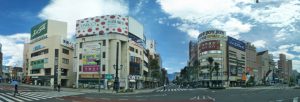Ekimae Hiroba: Practical & Historical Matters, Right Outside the Station

Greetings Good Visitor, and welcome to Matsumoto Ekimae, the wide open plaza outside the main entrance of Matsumoto Station. Whether you arrive by train or highway bus, this will likely be your first live view of town. And while you may be itching to dump your bag and head for the castle, your introduction to Matsumoto begins right here.
Let’s take a quick tour of the highlights.
Right in front of you as you reach the bottom of the stairs (or the escalator for you lazy people) is the roundabout for the city buses that can take you to the most popular and desirable places in town. That said, Matsumoto is generally quite compact – many of the places people want to see are well within walking distance. (Grab a map of downtown at the visitor information center inside the station, right across from the ticket gate, and you’ll see what I mean.) Besides, what better way to get to know a place than to take it in on a stroll at your own pace?
Note: one exception to this might be Asama Onsen. While a trip to this hot spring area can involve a nice walk up the Metoba River, on foot it’s a good hour from the station, and 45 minutes or so from the castle. (Idea: If you are set on visiting this onsen village and want a fun way to get there, rent a bicycle for free and pedal your way up the river. Ask about ‘sui-sui’ rent-a-cycles at the info center.)
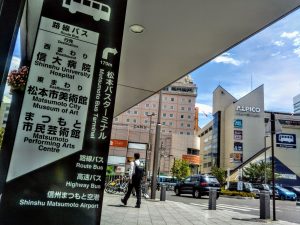
On the other hand, the buses that go beyond most people’s walking (and cycling) limits – places like Takayama, Nagoya, Tokyo and Osaka – depart from the Alpico Bus Terminal across the street.
If you want to head for the mountains, this is also where you want to go, with buses going to Norikura and Kamikochi. But beware! There is only one bus per day from here to Kamikochi, departing at 5:30am. All other Kamikochi-bound buses leave from Shin-shimashima Station, a thirty-minute ride up the Matsumoto Dentetsu Kamikochi Line. Get off at the last stop and jump on the bus to Kamikochi there.
Get all the juicy details at the visitor information center, at the ticket counter inside the bus terminal, or on Alpico’s website where you’ll find lots of other tasty bits of info, all in English.
So…hungry now? If so, no problem. Turn right as soon as you step outside the station and you’ll find a bread-based cafe that will make you feel like you are actually in a French bakery in Japan. Go a few steps further for something a bit more authentic. Like handmade local soba…
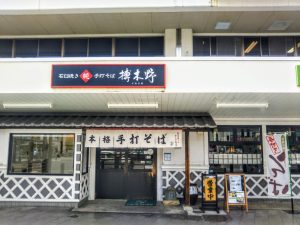
…or choose from a dizzying array of ramen, gyoza, and fried rice, not to mention more soba…
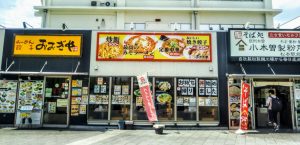
…or fried stuff on a stick, or chunks of fried chicken at this place that also offers all-you-can-drink lemon sours, flowing from a faucet right there at your seat. Dangerous.
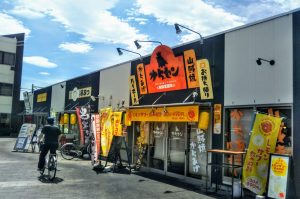
Okay, enough with the practicalities. Let’s get into what makes Matsumoto Ekimae unique. (Then you can go dump your bag.)
Placed prominently between the rows of taxis operated by a bunch of retired men hoping they don’t have to pick up any foreigners and a row of rental bicycles operated by a system that seems designed to make sure no foreigners use them is a three-sided stone clock tower. (Tower may be a generous term but then again so is French bakery.)
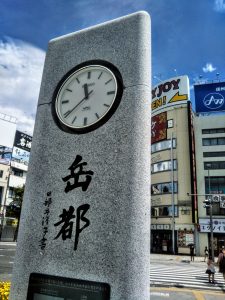 Walking away from the station building you’ll see this side of the clock tower first. Those two large Kanji (Chinese characters) read “Gaku-to”, meaning Mountain Metropolis (a beyond generous term for this town).
Walking away from the station building you’ll see this side of the clock tower first. Those two large Kanji (Chinese characters) read “Gaku-to”, meaning Mountain Metropolis (a beyond generous term for this town).
Naturally, with mountains on all sides, Matsumoto is well-known for its climbing and hiking. Interestingly, mountaineering was not much of a thing in Japan until British missionary Walter Weston showed up around the turn of the 20th Century, climbing all over and subsequently bringing his stories of the Japanese Alps to the rest of the world. Weston, along with Edward Bramwell Clarke, who is also credited with introducing rugby to Japan, did much to spark the idea of mountaineering as a form of recreational sport among the Japanese.
In earlier times the mountains around here – and everywhere else in Japan – were mainly a part of the spiritual realm of life. We’ll get into that with the statue of Banryu Jonin on the far side of the plaza.
Each of the other two sides of our clock pylon sports two Kanji as well. On one, the characters read “Gaku-to” while on the other they read “Gaku-to”. Yes, all three sides are pronounced the same. The zany spirit of the Japanese people is truly immeasurable.
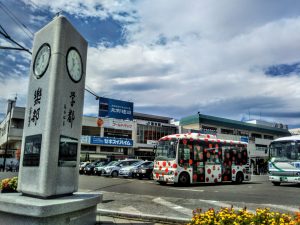
Of course the meaning on each side is different. The Kanji on the left side (in the photo above) mean “Music Metropolis” while those on the side facing the karaoke bar across the street (which makes little sense when you think too much about it) mean “Education Metropolis”.
Matsumoto’s reputation as a musical town (such as it is) comes via two prominent figures.
Seiji Ozawa was born in Shenyang, northeast China, to his Japanese parents. As a junior high school student in Tokyo he was interested in the piano, but he sprained a finger playing rugby (thanks Ed Clarke) and subsequently turned to conducting when Hideo Saito, his musical mentor, brought him to a performance of Beethoven’s Piano concerto Number 5.
To Ed Clarke’s great relief Ozawa went on to achieve extensive international acclaim as a conductor, and in 1992 realized what was perhaps his greatest dream: establishing an international music festival here in Matsumoto, the Saito Kinen Matsumoto Festival, in honor of Hideo Saito, the man who changed his life.
Shinichi Suzuki was born in Nagoya, and at a young age taught himself violin by learning and recreating recordings he had listened to. This would eventually lead to his firm belief in the inherent capacity of young children to learn anything through exposure and nurturing, and the development of the world-renowned Suzuki Method of learning to play music.
In 1924 Suzuki went to Germany to study the violin, and would in time return to Japan with his German wife to begin teaching children music in Tokyo. During WWII Suzuki and his wife spent some time apart in the interests of safety, reuniting after the war and moving to Matsumoto where Suzuki would continue to teach. His life and his work are memorialized in the Shinichi Suzuki Kinenkan museum, accessible via the bus going to Shinshu University-Asama Onsen – or a thirty-minute walk from the clock.
As far as the third “Gaku-to” goes, Matsumoto prides itself on its reputation as one of the earliest centers of modern education in Japan. This is in large part due to the establishment of the Kaichi School, one of the first schools in Japan to open after the education reforms of the early Meiji Era. The Former Kaichi School is now a registered National Treasure while additional historical buildings – namely the former High School located straight east from the station in Agata-no-mori Park, and the Former Yamabe Elementary building further east – round out the still-standing traditions of education in Matsumoto.
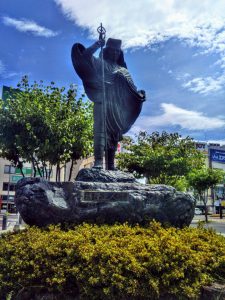 On the opposite side of this ekimae ‘hiroba’ (plaza) is a statue of a man introduced above. (No, not Ed Clarke. He was on the short list to get a statue until Seiji Ozawa hurt his finger and never regained his good graces among the statue committee crowd.) This is Banryu Shonin – priest of Pure Land Buddhism, avid mountain climber, and compulsive statue distributor.
On the opposite side of this ekimae ‘hiroba’ (plaza) is a statue of a man introduced above. (No, not Ed Clarke. He was on the short list to get a statue until Seiji Ozawa hurt his finger and never regained his good graces among the statue committee crowd.) This is Banryu Shonin – priest of Pure Land Buddhism, avid mountain climber, and compulsive statue distributor.
Born in present-day Toyama in 1782, Banryu Shonin spent a good chunk of his time in the mountains practicing nenbutsu, a Buddhist ritual that usually involved chanting “Namu Amida Butsu” in homage to the Buddha Amida.
Shonin made his way clear over the northern alps and landed here in Shinshu, visiting Genkoji Temple in 1826 where he (a) learned about sankei Mandara, paintings meant to encourage spiritual pilgrimages to various sacred sites; (b) began sharing his Buddhist acumen with members of the community, often bringing them to the mountains; and (c) decided to litter the northern alps with statues of various Buddhist deities.
Shonin traveled southwest, through many towns and villages on his way to Osaka where he would sculpt a small army of statues and haul them back to Shinshu. His first and foremost ambition, it seemed, was to bring his Buddhism to the top of 3,180-meter Yari-ga-take.
In 1828, on his second attempt, Shonin succeeded in reaching the sharp, steep peak of Yari, thereby opening the mountain for future generations of Buddhist pilgrims and, in time, selfie-takers.
Not far from Banryu Shonin you’ll find a blocky sort of water fountain. The downtown Matsumoto area is actually blessed with a great number of underground springs where you can fill up your water bottle or drink directly from the source. Keep your eyes open as you explore. (Or try to score a map.)
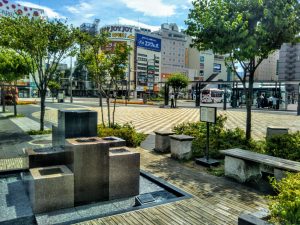
From this ekimae area Matsumoto lays spread out before you. Down the wide avenue leading directly east you can catch a glimpse of the Utsukushi-ga-hara Highlands, a full 2,000 meters above sea level and a great place to view the countless peaks surrounding Matsumoto on every side. Down the narrower side streets to the left and right of the McDonald’s over there you’ll find a veritable wonderland of food and drink, comprised of both Japanese tradition and international flair (with, of course, the requisite karaoke mixed in).
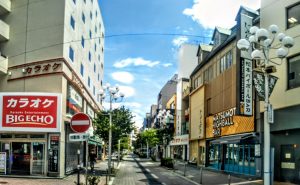
As you make your way around the ekimae area, heading on your way to (finally) drop your bag somewhere, keep your eyes open for a thousand more bits of uniqueness scattered about the station area.
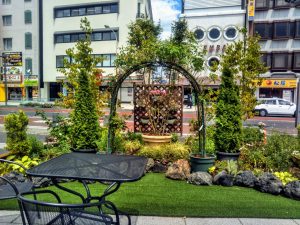
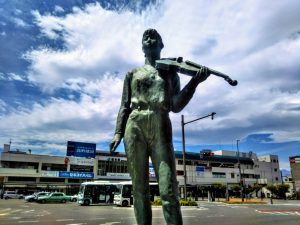
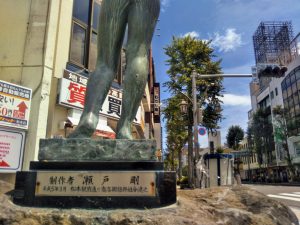
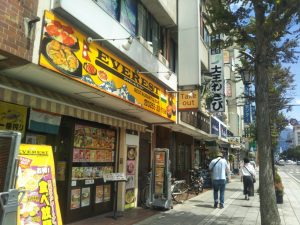
Just remember to leave time for the castle. 😉
